Mitral Valve Disease Therapeutics Market Research, 2032
The global mitral valve disease therapeutics market was valued at $607.7 million in 2022, and is projected to reach $803.4 million by 2032, growing at a CAGR of 2.8% from 2023 to 2032. Mitral valve disease refers to any condition that affects the mitral valve, which is one of the four valves in the heart that helps regulate blood flow. The mitral valve allows blood to flow from the left atrium to the left ventricle, and when it is not functioning properly, it can lead to symptoms such as shortness of breath, fatigue, chest pain, and heart palpitations.
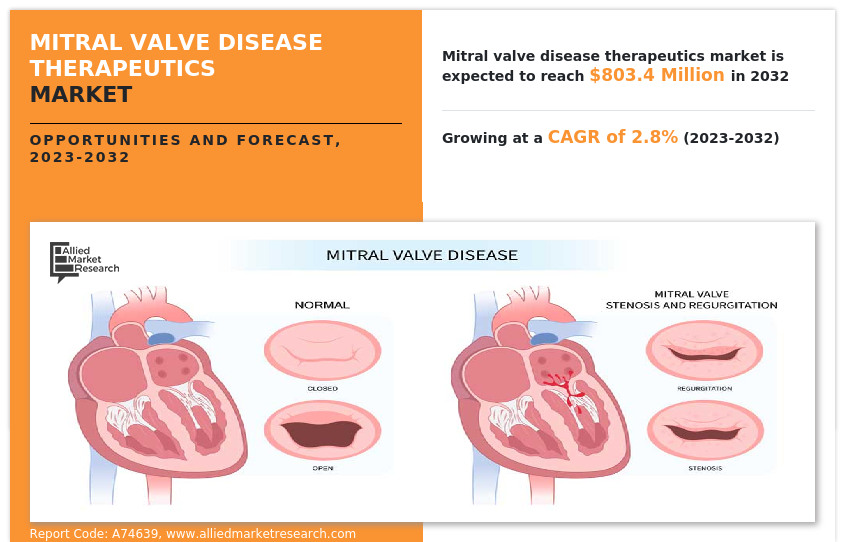
Market Dynamics
The major factors fueling the growth of mitral valve disease therapeutics market are rise in geriatric population, increase in prevalence of mitral valve disease conditions, and rise in adoption of therapeutic agents to manage the symptoms of mitral valve disease. As the global population continues to age, the prevalence of mitral valve disease is expected to increase, resulting in demand for novel therapeutics to manage the symptoms of the condition. For instance, according to the World Health Organization (WHO), the number of people aged 60 years and older is expected to double by 2050, reaching 2.1 billion. Mitral valve disease is more common in older individuals, and as the population ages, the demand for mitral valve disease therapeutics is expected to increase.
In addition, congenital defects can affect the structure of the mitral valve. Some congenital defects can cause the valve to be too small, too large, or to have an abnormal shape, which can lead to mitral valve stenosis or regurgitation. Further, infections can also cause mitral valve disease. Endocarditis, which is an infection of the lining of the heart and heart valves, can cause damage to the mitral valve. This damage can lead to mitral valve stenosis or regurgitation. Thus, rise in prevalence of mitral valve conditions owing to congenital defects and infections results in demand for therapeutic agents and drives the demand for novel therapeutics.
In addition, the rise in heart valve replacement surgeries is likely to drive the mitral valve disease therapeutics market, as these surgeries often require the use of drugs to manage symptoms or prevent complications. The surgery involves removing the diseased valve and replacing it with either a mechanical valve or a biological valve. After the surgery, patients require drugs to prevent blood clots or manage symptoms such as heart rhythm problems. Additionally, some patients may require long-term medication to prevent infection or manage other conditions such as high blood pressure or high cholesterol. The rise in heart valve replacement surgeries can therefore drive the demand for mitral valve disease therapeutics market, especially those used in the post-operative period.
Further, advancements in diagnostic technologies are also driving the mitral valve disease therapeutics market. Improved diagnostic tools and techniques allow earlier detection of mitral valve disease and more accurate diagnosis. For instance, echocardiography is a non-invasive diagnostic test that uses ultrasound waves to create images of the heart. It is commonly used to diagnose the mitral valve disease and monitor its progression. With improved diagnostic techniques, healthcare providers can identify the mitral valve disease earlier, and patients can receive treatment earlier, improving outcomes and reducing healthcare costs. The growth of the mitral valve disease therapeutics market is expected to be driven by emerging markets, owing to availability of improved healthcare infrastructure, increase in unmet healthcare needs, and rise in prevalence of cardiovascular diseases such as mitral valve conditions which results in rise in demand for novel therapeutic agents.
Moreover, rise in mitral valve replacements or repair procedures is anticipated to boost the growth of market. Mitral valve disease is associated with an increased risk of blood clots and stroke, particularly in patients with atrial fibrillation (an irregular heartbeat) or who have undergone mitral valve replacement surgery. Anticoagulant medications, commonly referred to as blood thinners, are often prescribed to reduce this risk. Anticoagulants work by preventing blood clots from forming or by breaking down existing blood clots. Commonly prescribed anticoagulants for patients with mitral valve disease include warfarin, rivaroxaban, and apixaban. Thus, rise in adoption of anticoagulants in mitral valve disease management propels the market expansion.
Furthermore, the healthcare industry in emerging economies is developing at a significant rate, owing to rise in demand for enhanced healthcare services, significant investments by government to improve healthcare infrastructure, and development of the medical tourism industry in emerging countries. Moreover, governments in many countries are investing in healthcare infrastructure and promoting the research and development activities related to cardiovascular diseases and available treatment options. This creates opportunities for market growth and adoption of therapeutic agents for managing symptoms of mitral valve disease.
However, availability of mitral valve replacement and repair procedures restrains the growth of the mitral valve disease drugs market. Mitral valve replacement and repair procedures are surgical interventions that can treat mitral valve disease by replacing or repairing the damaged valve. These procedures have been shown to be highly effective in improving symptoms and reducing the risk of complications in patients with severe mitral valve disease. Thus, restraining the growth of mitral valve disease therapeutics market forecast.
The outbreak of COVID-19 has disrupted workflows in the health care sector around the world. The pandemic has disrupted healthcare systems globally, leading to delays in the diagnosis and treatment of many diseases, including mitral valve disease. The COVID-19 pandemic had also caused some patients to avoid seeking medical care because they were afraid of getting infected. This has led to more delays in diagnosis and treatment for mitral valve disease, which had negative impact on the market. Additionally, global supply chains have been disrupted, which has resulted in a shortage of some drugs used to treat mitral valve disease. This shortage has further affected the growth of the market. Thus, COVID-19 negatively impacted the growth of the mitral valve disease therapeutics industry.
Segmental Overview
The global mitral valve disease therapeutics market is segmented into drug class, age group, distribution channel, and region. On the basis of drug class, the market is categorized into beta blockers, diuretics, anticoagulants, and others. As per age group, the market is categorized into below 55 years and above 55 years. According to distribution channel, the market is segregated into hospital pharmacies, drug stores and retail pharmacies, and online providers. Region wise, the market is analyzed across North America (the U.S., Canada, and Mexico), Europe (Germany, France, the UK, Italy, Spain, and rest of Europe), Asia-Pacific (Japan, China, Australia, India, South Korea, and rest of Asia-Pacific), and LAMEA (Brazil, South Africa, Saudi Arabia, and rest of LAMEA).
By Drug Class
Based on drug class, the anticoagulant segment accounted for largest mitral valve disease therapeutics market size in 2022 and is expected to remain dominant during forecast period owing to rise in number of mitral valve replacement procedures, rise in adoption of anticoagulants in managing the symptoms of mitral valve disease, and wide availability of direct acting oral anticoagulants (DOACs).
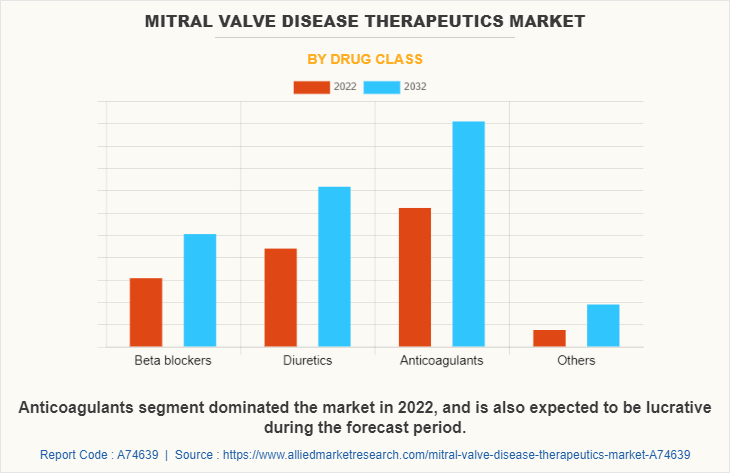
By Age Group
Based on age, the above 55 years segment accounted for largest mitral valve disease therapeutics market size in 2022 and is expected to register highest CAGR during the forecast period owing to age-related degenerative changes, rise in geriatric population, and higher prevalence of comorbidities in this age group.
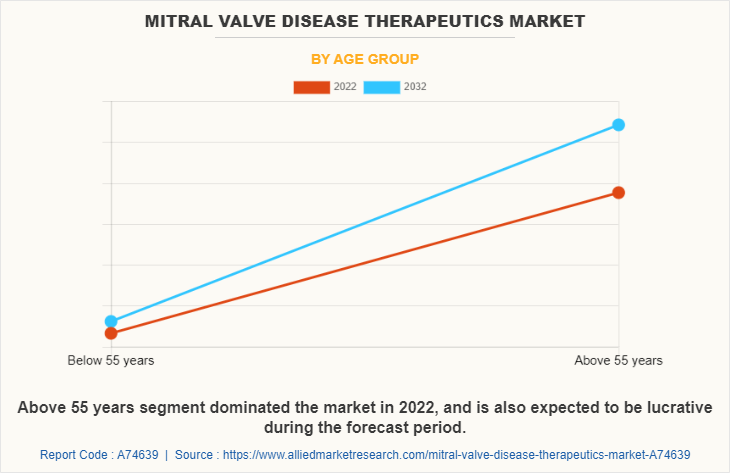
By Distribution Channel
Based on distribution channel, the drug stores and retail pharmacies segment occupied largest mitral valve disease therapeutics market share in 2022 and is expected to remain dominant during the forecast period owing to accessibility of retail pharmacies everywhere and large chain of distribution networks. The online providers segment is projected to register the highest CAGR during the forecast period owing to the increase in popularity of online providers and ability of online providers to offer medication reminders and refill notifications that help improve medication adherence and ultimately improve patient outcomes thus also boosting the mitral valve disease therapeutics market opportunity.
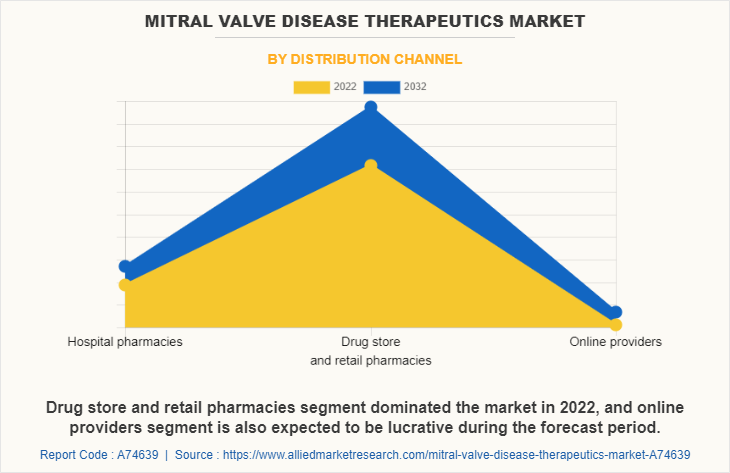
By Region
The mitral valve disease therapeutics market is analyzed across North America, Europe, Asia-Pacific, and LAMEA. North America accounted for largest mitral valve disease therapeutics market share in terms of revenue in 2022. This mitral valve disease therapeutics market growth is attributed to a rise in prevalence of mitral valve diseases and early diagnosis of valvular heart diseases. In addition, the increase in the geriatric population in North America has led to a higher prevalence of heart diseases, leading to increased demand for mitral valve therapeutics. Moreover, North American healthcare system has made significant investments in improving healthcare infrastructure and facilities, which has enabled better access to healthcare services and treatments for patients with heart diseases. However, Asia-Pacific is expected to witness highest growth during the forecast period, owing to rising prevalence of mitral valve disease, increasing healthcare expenditure, and increasing awareness about the importance of early detection and treatment of mitral valve disease which is also expected to boost market growth.
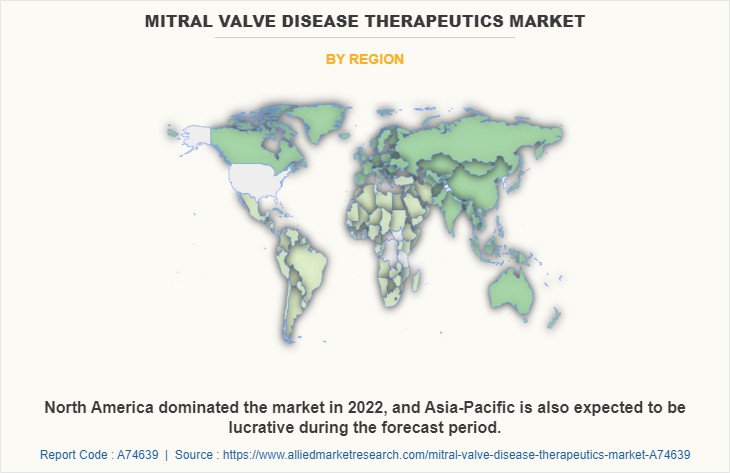
The presence of several major players, such as Pfizer Inc., Novartis AG, Zydus Lifesciences Limited, Viatris Inc. and the wide availability of advanced digital X-ray system in the North America region drives the growth of the mitral valve disease therapeutics market. Furthermore, the presence of well-established healthcare infrastructure, and rise in adoption of various class of therapeutics to manage the symptoms of mitral valve disease are expected to drive the market growth.
Asia-Pacific is expected to grow at the highest rate during the forecast period. Asia- Pacific mitral valve disease therapeutics industry is being driven by several factors, including increasing prevalence of cardiovascular diseases, rising demand for novel therapeutics, increasing investment in healthcare infrastructure, growing geriatric population, and favorable government initiatives regarding cardiovascular diseases. The Asia-Pacific region has become a hub for mitral valve disease therapeutics market owing to its large population, diverse patient pool, and relatively lower treatment costs of mitral valve diseases. The high prevalence of cardiovascular diseases, such as hypertension and stroke, which increases the risk for mitral valve disease is driving the demand for novel therapeutic agents.
Moreover, Asia-Pacific offers profitable opportunities for key players operating in the mitral valve disease therapeutics market, thereby registering the fastest growth rate during the forecast period, owing to the growing infrastructure of industries, rising research, as well as well-established presence of domestic companies in the region. In addition, rise in contract manufacturing organizations within the region provides great opportunity for new entrants in this region. Furthermore, presence of key players offering the therapeutic agents to manage the symptoms is anticipated to drive the market growth. For instance, key players such as Sun Pharmaceutical Industries Limited, Cipla Ltd., and Zydus Lifesciences Limited offer various class of drugs such as beta blockers, calcium channel blockers, and diuretic agents. Thus presence of key players drives the market growth.
Competition Analysis
Competitive analysis and profiles of the major players in the mitral valve disease therapeutics market, such as Zydus Lifesciences Limited, Pfizer Inc., Bayer AG, Novartis AG, Viatris Inc., Alembic Ltd., Teva Pharmaceutical Industries Ltd., Cipla Ltd., Sun Pharmaceutical Industries Limited, and Sanofi are provided in this report.
Key Benefits For Stakeholders
- This report provides a quantitative analysis of the market segments, current trends, estimations, and dynamics of the mitral valve disease therapeutics market analysis from 2022 to 2032 to identify the prevailing mitral valve disease therapeutics market opportunities.
- The market research is offered along with information related to key drivers, restraints, and opportunities.
- Porter's five forces analysis highlights the potency of buyers and suppliers to enable stakeholders make profit-oriented business decisions and strengthen their supplier-buyer network.
- In-depth analysis of the mitral valve disease therapeutics market segmentation assists to determine the prevailing market opportunities.
- Major countries in each region are mapped according to their revenue contribution to the global market.
- Market player positioning facilitates benchmarking and provides a clear understanding of the present position of the market players.
- The report includes the analysis of the regional as well as global mitral valve disease therapeutics market trends, key players, market segments, application areas, and market growth strategies.
Mitral Valve Disease Therapeutics Market Report Highlights
| Aspects | Details |
| Market Size By 2032 | USD 803.4 million |
| Growth Rate | CAGR of 2.8% |
| Forecast period | 2022 - 2032 |
| Report Pages | 268 |
| By Distribution channel |
|
| By Drug class |
|
| By Age group |
|
| By Region |
|
| Key Market Players | Zydus Lifesciences Limited, Sanofi, Alembic Ltd, Sun Pharmaceutical Industries Limited, Teva Pharmaceutical Industries Ltd., Novartis AG, Cipla Ltd, Pfizer Inc., Bayer AG, Viatris Inc. |
Analyst Review
This section provides various opinions of top-level CXOs in the global mitral valve disease therapeutics market. According to the insights of CXOs, increase in demand for novel therapeutics and rise in investments globally is expected to offer profitable opportunities for the expansion of the market. In addition, favorable government initiatives and rising awareness about available medications, has piqued the interest of several companies to develop novel therapeutics.
CXOs further added that increase in adoption of medications such as beta blockers, anticoagulants, and diuretics is expected to boost the growth of the market. In addition, increasing burden of cardiovascular diseases across the globe has resulted in rise in demand for novel therapeutics, thus driving the growth of the market. Further, geriatric people are prone to mitral valve conditions. Thus, rise in number of geriatric population results in rise in demand for effective novel medications, thereby driving the growth of the market.
Furthermore, North America accounted for largest share in terms of revenue in 2022. This growth is attributed to rise in prevalence of mitral valve diseases, adoption of therapeutics to manage mitral valve conditions, and early diagnosis of valvular heart diseases. However, Asia-Pacific is expected to witness highest growth during the forecast period, owing to increasing awareness about mitral valve conditions and available therapeutics, rising prevalence of mitral valve disease, and growing healthcare expenditure.
The major factor that fuels the growth of the mitral valve disease therapeutics market are increase in prevalence of mitral valve disease, rise in geriatric population, and rise in adoption of various medications to manage the symptoms associated with mitral valve conditions.
The medications such as beta blockers, diuretics, anticoagulants, and others are used to manage symptoms and improve heart function in mitral valve disease.
The total market value of mitral valve disease therapeutics market is $607.74 million in 2022.
Top companies such as, Zydus Lifesciences Limited, Pfizer Inc., Bayer AG, Novartis AG, Viatris Inc., and Sanofi held a high market position in 2022. These key players held a high market postion owing to the strong geographical foothold in North America, Europe, Asia-Pacific, and LAMEA.
The forecast period for mitral valve disease therapeutics market is 2023 to 2032
The market value of mitral valve disease therapeutics market in 2032 is $803.44 million.
Mitral valve disease is a condition that affects the mitral valve, which is located between the left atrium and left ventricle of the heart.
Loading Table Of Content...
Loading Research Methodology...



